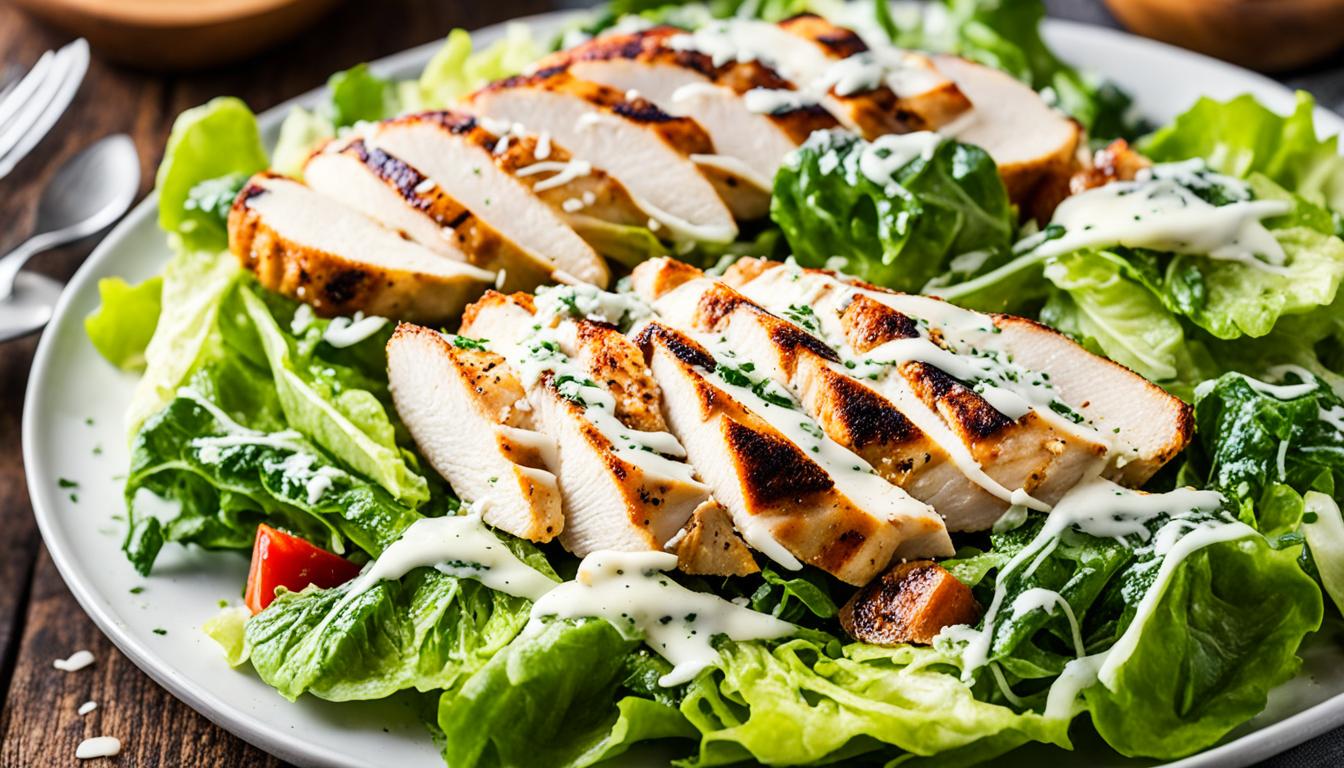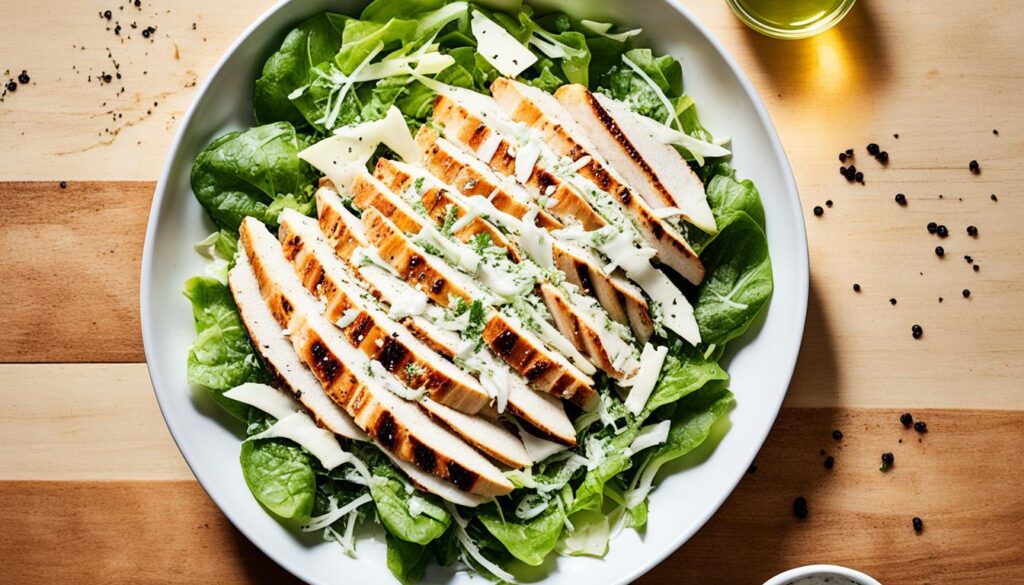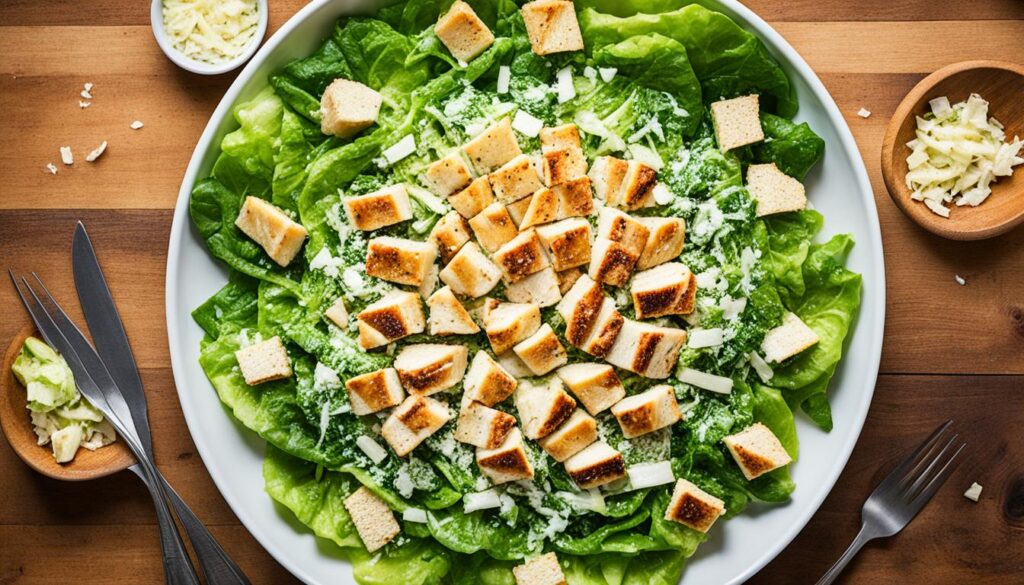Calorie Count in Chicken Caesar Salad Unveiled

Welcome to our in-depth exploration of the calorie count and nutritional information of the delectable Chicken Caesar Salad. If you’re wondering about the impact this popular dish has on your diet, you’ve come to the right place. By understanding the calorie content and other nutritional facts, you can make informed dietary choices without compromising on taste and satisfaction.
Are you curious about how many calories are in a serving of Chicken Caesar Salad? Or perhaps you want to know more about its overall nutritional value? In this article, we will provide you with comprehensive insights into the calorie count, nutritional breakdown, and more. Get ready to dive into the world of tantalizing flavors and healthy choices!
Key Takeaways:
- Discover the calorie count and nutritional facts of Chicken Caesar Salad
- Gain a better understanding of the macronutrient breakdown and essential vitamins and minerals it contains
- Learn how to calculate the calorie count per serving to manage your daily caloric intake more effectively
- Explore the individual ingredients of Chicken Caesar Salad and their respective calorie contributions
- Unlock tips for creating a healthier version of the salad that aligns with your dietary goals and preferences
Chicken Caesar Salad: A Nutritional Overview
In this section, we will provide a comprehensive overview of the nutritional facts of a Chicken Caesar Salad. From the macronutrient breakdown to the vitamins and minerals it contains, you will gain a better understanding of the health benefits it offers.
A Chicken Caesar Salad is a popular choice for those looking for a delicious and nutritious meal. Let’s take a closer look at its nutritional profile:
| Nutrient | Amount per Serving |
|---|---|
| Calories | 250 |
| Protein | 20g |
| Fat | 15g |
| Carbohydrates | 10g |
| Fiber | 4g |
| Sodium | 500mg |
| Calcium | 150mg |
| Vitamin A | 1000IU |
| Vitamin C | 15mg |
As you can see, a Chicken Caesar Salad contains a moderate amount of calories, making it a suitable option for individuals who are watching their caloric intake. It is also rich in protein, which helps to keep you satiated and supports muscle growth and repair.
Additionally, the salad provides a good mix of healthy fats, carbohydrates, and fiber. The fiber content aids digestion and promotes feelings of fullness, while the carbohydrates provide energy for your daily activities.
Moreover, a Chicken Caesar Salad is a good source of essential vitamins and minerals. The calcium content contributes to bone health, while the vitamin A and vitamin C support immune function and overall well-being.
Whether you’re looking to enjoy a nutritious lunch or want to incorporate more greens into your diet, a Chicken Caesar Salad is a smart choice. With its well-rounded nutritional profile, it provides a balanced mix of macronutrients and essential micronutrients.
Calculating the Calorie Count in Chicken Caesar Salad
When it comes to managing your daily caloric intake, understanding the calorie count of the foods you consume is essential. In this section, we will explore the calorie count of a typical serving of Chicken Caesar Salad, providing you with the information you need to make informed dietary choices.
The calorie content of a Chicken Caesar Salad can vary based on the specific ingredients used and the portion size. Let’s take a closer look at some of the main components:
- Romaine Lettuce: One cup of chopped romaine lettuce contains approximately 8 calories.
- Grilled Chicken: Three ounces of grilled chicken breast contribute around 142 calories.
- Caesar Dressing: Two tablespoons of Caesar dressing can add about 160 calories.
- Croutons: A quarter cup of croutons contains around 70 calories.
- Parmesan Cheese: One tablespoon of grated Parmesan cheese adds approximately 22 calories.
By adding up the calorie content of each ingredient and adjusting for the serving size, you can determine the total calorie count of your Chicken Caesar Salad. Here’s a breakdown per serving:
| Ingredients | Calories per Serving |
|---|---|
| Romaine Lettuce | 8 |
| Grilled Chicken | 142 |
| Caesar Dressing | 160 |
| Croutons | 70 |
| Parmesan Cheese | 22 |
| Total Calories | 402 |
Keep in mind that these figures are approximate and can vary depending on the specific brands and variations of the ingredients used in your Chicken Caesar Salad. Paying attention to portion sizes and opting for lighter versions of certain ingredients, such as low-fat dressing or reduced-fat cheese, can help reduce the overall calorie count.
Being aware of the calorie content in your favorite dishes empowers you to make healthier choices without sacrificing taste. Now that you have a better understanding of the calorie count in Chicken Caesar Salad, you can enjoy this delicious dish while staying mindful of your dietary goals.

Ingredients and Calorie Breakdown in Chicken Caesar Salad
When it comes to maintaining a healthy diet, understanding the calorie content of your meals is crucial. In this section, we will break down the ingredients of a classic Chicken Caesar Salad and explore their respective calorie contributions. Armed with this knowledge, you can make informed decisions about the portions and ingredients you choose for your salad.
Let’s take a closer look at the key components of a Chicken Caesar Salad:
- Romaine Lettuce: Romaine lettuce is the base of a chicken Caesar salad, providing a crisp and refreshing texture. While being low in calories, it is rich in vitamins, minerals, and fiber.
- Grilled Chicken: Grilled chicken adds a significant source of protein to the salad. Protein is essential for muscle growth and repair. A 3-ounce serving of grilled chicken contributes around 130-150 calories, depending on the cooking method and any added seasonings.
- Croutons: Croutons are small pieces of bread that are typically toasted or fried to add a crunchy element to the salad. However, they can also add extra calories and carbohydrates to your meal. It is important to be mindful of portion sizes and consider healthier alternatives, such as whole-grain croutons or homemade baked versions.
- Parmesan Cheese: Parmesan cheese is a common ingredient in a Caesar salad, adding a savory flavor and a creamy texture. However, it is also high in calories and saturated fats. Moderation is key when adding Parmesan cheese to your salad, and you may consider using a lesser amount or opting for a lower-fat cheese alternative.
- Caesar Dressing: The classic Caesar dressing is a creamy blend of ingredients like garlic, lemon, anchovies, and olive oil. While it contributes to the distinct flavor of the salad, it also adds significant calories and fat. Be cautious of the amount of dressing you use, or consider making a lighter version using reduced-fat ingredients.
Here’s a breakdown of the approximate calorie content of a typical Chicken Caesar Salad:
| Ingredient | Calories |
|---|---|
| Romaine Lettuce (2 cups) | 20 |
| Grilled Chicken (3 oz) | 130-150 |
| Croutons (1 serving) | 60-80 |
| Parmesan Cheese (1 tbsp) | 20-30 |
| Caesar Dressing (2 tbsp) | 150-200 |
Keep in mind that these values are approximate and can vary based on specific brands or homemade variations. Monitoring the portion sizes and making healthier ingredient choices can help you create a Chicken Caesar Salad that aligns with your calorie goals.

Conclusion
After exploring the calorie count and nutritional information of Chicken Caesar Salad, it is clear that this popular dish can be enjoyed as a healthy option that aligns with your dietary goals. By making a few simple adjustments, you can create a version of the salad that is both delicious and nutritious.
One way to make your Chicken Caesar Salad healthier is by incorporating healthy ingredient substitutions. For example, you can opt for grilled chicken instead of fried chicken to reduce the calorie content. Additionally, using low-fat or light dressing can significantly decrease the fat and calorie content without compromising on taste.
Portion control is another important factor to consider when enjoying Chicken Caesar Salad. By being mindful of your serving size, you can ensure that you’re consuming an appropriate number of calories. Adding more vegetables and greens to your salad can help increase its volume while keeping the calorie count in check.
FAQ
How many calories are in a Chicken Caesar Salad?
The calorie count in a Chicken Caesar Salad can vary depending on the portion size and specific ingredients used. On average, a typical serving of Chicken Caesar Salad contains around 350-600 calories.
What is the nutritional value of a Chicken Caesar Salad?
A Chicken Caesar Salad is a good source of protein, healthy fats, and essential nutrients. It typically provides a balanced combination of carbohydrates, protein, and fats, along with vitamins (such as vitamin A, C, K), minerals (such as calcium, iron), and fiber.
How can I calculate the calorie count in a Chicken Caesar Salad?
To calculate the calorie count in a Chicken Caesar Salad, you can refer to the nutritional information provided on the packaging or log the ingredients you use and their respective calorie content. By summing up the calories in each ingredient, you can determine the total calorie count.
What are the calorie contributions of the ingredients in a Chicken Caesar Salad?
The calorie contributions of the ingredients in a Chicken Caesar Salad can vary based on the brand and recipe. However, on average, the primary calorie contributors are the chicken, dressing, croutons, and Parmesan cheese. Adding or removing ingredients can affect the overall calorie count.
How can I make a healthier version of a Chicken Caesar Salad with fewer calories?
To make a healthier version of a Chicken Caesar Salad with fewer calories, you can opt for grilled or baked chicken instead of fried chicken. Use a light dressing or make your own healthier dressing using ingredients like Greek yogurt and lemon juice. Consider reducing or omitting high-calorie ingredients like croutons and cheese, or using healthier alternatives like whole wheat croutons and reduced-fat cheese.







